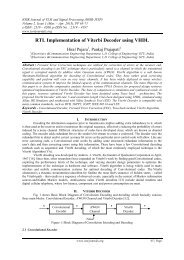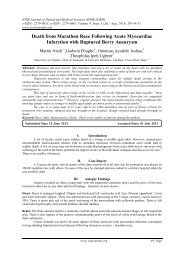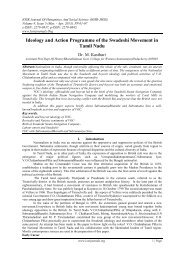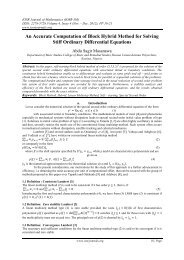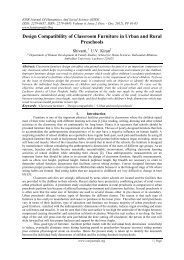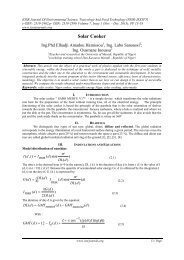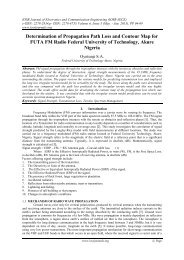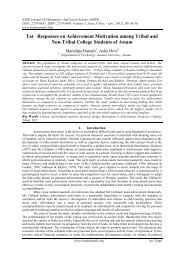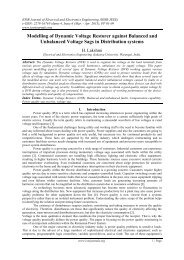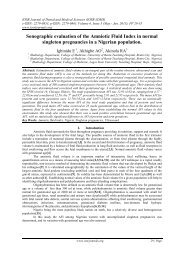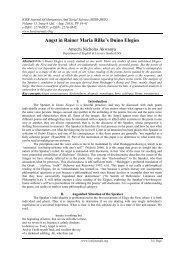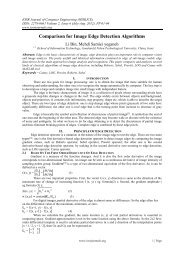Initial Conquest of India by Turks and Their Slaves - IOSR
Initial Conquest of India by Turks and Their Slaves - IOSR
Initial Conquest of India by Turks and Their Slaves - IOSR
You also want an ePaper? Increase the reach of your titles
YUMPU automatically turns print PDFs into web optimized ePapers that Google loves.
<strong>Initial</strong> <strong>Conquest</strong> Of <strong>India</strong> By <strong>Turks</strong> And <strong>Their</strong> <strong>Slaves</strong><br />
centre in Saurashtra-Gujrat (which had been deemed safe behind the desert <strong>and</strong> boasted „the greatest idol <strong>of</strong> al-<br />
Hind‟),was destroyed in 1025-6. Mahmuds son <strong>and</strong> successor Masud(r.1030-41) did not ab<strong>and</strong>on plunder raids<br />
<strong>and</strong> military campaigns deep into <strong>India</strong>, beyond the confines <strong>of</strong> the area which was now the formal Ghaznavid<br />
dominion under an investure patent sent from Baghdad in 1030-31. In 1030-31 a significant new initiative was<br />
the first invasion <strong>of</strong> Awadh under Sayyid Salar Masud Ghazi, a nephew <strong>of</strong> Mahmud, who had been born in<br />
1015.From a military point <strong>of</strong> view, it was a complete failure, <strong>and</strong> hardly any <strong>of</strong> the invaders returned alive. An<br />
account <strong>of</strong> it is given in an historical romance written <strong>by</strong> a sufi,`Abd ar-Rehman Chishti‟ during the reign <strong>of</strong> the<br />
Mughal emperor Jahangir entitled `Mirat-i-Masudi‟.This work is said <strong>by</strong> its author to have been mainly based on<br />
a book called the `Tawarikh-i-Mahmudi‟ written <strong>by</strong> Mahmud Ghaznavi, a servant <strong>of</strong> Amir Sabuktigin <strong>and</strong> one<br />
<strong>of</strong> the followers <strong>of</strong> Sayyid Salar who related events <strong>of</strong> which he had personal knowledge. There are numerous<br />
tombs scattered all over the northern districts <strong>of</strong> Awadh,which are said to cover the remains <strong>of</strong> martyers <strong>of</strong><br />
Sayyid Salars army. Bahraich was probably reached in 1033, <strong>and</strong> Sayyid Salar appears to have been able to<br />
repeatedly defeated the local rais on the bank <strong>of</strong> river Kosala(probably Kauriala), until reinforcements arrived in<br />
the Hindu camp <strong>and</strong> the `Prince <strong>of</strong> martyrs‟ fell with virtually all his followers. Bahraich is still celebrated for<br />
the shrine <strong>of</strong> Sayyid Salar. Another successful attempt to seize the wealth <strong>of</strong> Banaras undertaken <strong>by</strong> a rebellious<br />
governor <strong>of</strong> the Punjab,Ahmad Nayaltigin, a son <strong>of</strong> Mahmud,in 1033.Nayaltigin joined <strong>by</strong> the ghazis <strong>and</strong> the<br />
army <strong>of</strong> Lahore crossed the Ganges <strong>and</strong> going down the left bank arrived at Banaras,`where no army <strong>of</strong> Islam<br />
had ever reached‟,plundering the markets <strong>and</strong> returning with great spoil. By 1033,the year <strong>of</strong> famine, it was<br />
becoming clear that the great age <strong>of</strong> Ghaznavid conquests was drawing to a close.The Seljuqs were rapidly<br />
emerging as the dominant power in the eastern Islamic world.<br />
The Ghaznavids retained their possessions in the northern <strong>and</strong> eastern Afghanistan, as well as their<br />
<strong>India</strong>n conquests for a century more,until the rise <strong>of</strong> the Ghurids.In the year 1079-80 there are reports <strong>of</strong> new<br />
campaigns under Ibrahim but the dates are not sure. Between 1066-1070,one <strong>of</strong> the Ibrahims sons appears to<br />
have led an army <strong>of</strong> Ghazis <strong>and</strong> 40,000 cavalry into the doab.Inscriptions <strong>of</strong> the Gahadavalas from 1090<br />
mentions a tax, called the `Turushkad<strong>and</strong>a‟,`Turkish Punishment‟,which was possibly a defence tax<br />
(Turkenhilfe) or an amount which was set apart to be paid as tribute to the Ghaznavids.After the death <strong>of</strong> Masud<br />
III in 1118,however, Seljuq suzerainty was established over Ghazna.The real menace to the Ghaznavids came<br />
not from the Seljuqs but from the Shansabanis <strong>of</strong> Ghur.<br />
Muizz-ud-Dins family, the Shansabanids, as designated <strong>by</strong> Minhaj-i-Siraj originated among the petty<br />
princes (muluk-sing. malik) <strong>of</strong> Ghur, the mountainous region east <strong>of</strong> Herat. The dynasty was designated as<br />
Shansabani‟s <strong>by</strong> Minha-i-Siraj as they descended from an ancestor named Shansab.In 12th century an event <strong>of</strong><br />
supreme importance for the history <strong>of</strong> central Asia happened <strong>and</strong> it was the rise <strong>of</strong> Khwarizm <strong>and</strong> Ghor <strong>and</strong> their<br />
eventual struggle for the mastery <strong>of</strong> Khurasan. Atsiz, the founder <strong>of</strong> khwarizms greatness, was originally a loyal<br />
vassal <strong>of</strong> Sanjar until jealously the latter‟s courtiers drove him to open revolt in 533/1138. Sanjar defeated him<br />
<strong>and</strong> appointed his nephew Sulaiman to his <strong>of</strong>fice. As soon as Sanjar‟s back was turned Atsiz advanced <strong>and</strong><br />
drove Sulaiman out <strong>of</strong> Khwarizm. Sanjar defeated him two more times in 538-1143 <strong>and</strong> 542/1147 respectively.<br />
Before Atsiz‟s death in 551/1156 he had annexed J<strong>and</strong> <strong>and</strong> Mankishlagh <strong>and</strong> had imposed something like<br />
suzerainty over the Khan <strong>of</strong> Samarq<strong>and</strong>. Arsalan-II, the successor <strong>of</strong> Atsiz, followed his father‟s imperialist<br />
policy with steadfast resolution. He provoked the Qarakhitai‟s to invade his territories in 567/1172, first <strong>by</strong><br />
siding with Khan <strong>of</strong> Samarq<strong>and</strong> in a conflict with Qarlughs <strong>and</strong> then <strong>by</strong> refusing to continue the annual tribute,<br />
Khwarizmi army was decisively defeated. In Khurasan the Khwarizm Shah failed to make much headway; the<br />
Ghuzz <strong>and</strong> lately, the Qarakhitai, arrested his efforts. His preoccupations, however provided opportunity to the<br />
rulers <strong>of</strong> the petty principality <strong>of</strong> Ghor, to extend their power quietly at the cost <strong>of</strong> the war leaders holding the<br />
province. From their insignificant position as the chiefs <strong>of</strong> the mountain fortress <strong>of</strong> Ghor, they came into<br />
prominence during the reign <strong>of</strong> Ghaznavid Bahram, who perfidiously murdered Malik Qutubuddin Hasan, a<br />
Ghorid prince who had taken refuge at his court <strong>and</strong> been married to one <strong>of</strong> Bahram‟s daughters. This roused the<br />
wrath <strong>of</strong> Saifuddin Suri, brother <strong>of</strong> the murdered prince, who thereupon invaded Ghazni <strong>and</strong> drove Bahram from<br />
the city. He soon returned in 543-1148 <strong>and</strong> taking advantage <strong>of</strong> the absence <strong>of</strong> the Ghoride troops, then<br />
wintering at home, seized Saifuddin <strong>and</strong> sent his head to Sanjar. Alauddin Hussain, Saifuddin‟s younger brother,<br />
then advanced on Ghazni <strong>and</strong> wreaked a terrible vengeance. After plundering the city he set fire to the buildings,<br />
which were left burning for seven days, <strong>and</strong> massacred the whole population. This action, which earned him the<br />
unenviable nickname <strong>of</strong> „Jahan Soz‟ (The world Burner), <strong>and</strong> he took for himself the title <strong>of</strong> Sultan. It was<br />
Husayn‟s nephew Ghiyath-ud-Din Muhammad b. Sam (558-599/1163-1203), who expelled the Ghuzz from<br />
Ghazna in 569/1173 <strong>and</strong> installed there his younger brother Muizz-ud-Din (formerly Shihab-ud-Din)<br />
Muhammad. Under Ghiyath-ud-Din <strong>and</strong> Muizz-ud-Din, who throughout cooperated more or less harmoniously,<br />
the Shansabanids or Ghurids, since they had reduced to Subordinate Status the other maliks <strong>of</strong> the region<br />
emerged as one <strong>of</strong> the great powers <strong>of</strong> the Islamic world. <strong>Their</strong> political seat was the fortress <strong>of</strong> Firuzkuh,<br />
identified <strong>by</strong> Andre Maricq in 1957 with ruins at Jam on the middle Hari Rud, some 200 Km. east <strong>of</strong> Herat.<br />
Encouraged <strong>by</strong> the Caliph, from whom he obtained the title Qasim Amir Al-Muminin (Partner <strong>of</strong> the<br />
www.iosrjournals.org<br />
3 | Page



